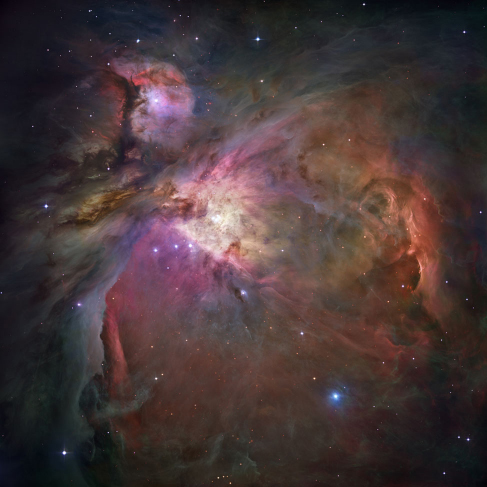Numbers in Astronomy
Numbers in Astronomy
In astronomy we deal with distances on a scale you may never have thought about before, with numbers larger than any you may have encountered. We adopt two approaches that make dealing with astronomical numbers a little bit easier. First, we use a system for writing large and small numbers called scientific notation (or sometimes powers-of-ten notation). This system is very appealing because it eliminates the many zeros that can seem overwhelming to the reader. In scientific notation, if you want to write a number such as 500,000,000, you express it as 5 × 108. The small raised number after the 10, called an exponent, keeps track of the number of places we had to move the decimal point to the left to convert 500,000,000 to 5.

Figure 1.4 Orion Nebula. This beautiful cloud of cosmic raw material (gas and dust from which new stars and planets are being made) called the Orion Nebula is about 1400 light-years away.
EXAMPLE 1.1
Scientific Notation
In 2015, the richest human being on our planet had a net worth of $79.2 billion. Some might say this is an astronomical sum of money. Express this amount in scientific notation.
Solution
$79.2 billion can be written $79,200,000,000. Expressed in scientific notation it becomes $7.92 × 1010.
EXAMPLE 1.2
Getting Familiar with a Light-Year
How many kilometers are there in a light-year?
Solution
Light travels 3 × 105 km in 1 s. So, let’s calculate how far it goes in a year:
There are 60 (6 × 101) s in 1 min, and 6 × 101 min in 1 h.
Multiply these together and you find that there are 3.6 × 103 s/h.
Thus, light covers 3 × 105 km/s × 3.6 × 103 s/h = 1.08 × 109 km/h.
There are 24 or 2.4 × 101 h in a day, and 365.24 (3.65 × 102) days in 1 y.
The product of these two numbers is 8.77 × 103 h/y.
Multiplying this by 1.08 × 109 km/h gives 9.46 × 1012 km/light-year.
That’s almost 10,000,000,000,000 km that light covers in a year. To help you imagine how long this distance is, we’ll mention that a string 1 light-year long could fit around the circumference of Earth 236 million times.
